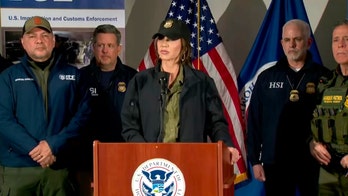Fox News Flash top headlines for February 18
Fox News Flash top headlines are here. Check out what's clicking on Foxnews.com.
While progress has been made on President Biden's goal to reopen most schools within 100 days after one month in office, nearly 60 percent of students are still not going to school full-time.
Currently, 41.9 percent of children K-12 are learning in the classroom five days per week, up from 35.4 percent on Jan. 19, one day before Biden took office, according to data gathered by school reopening tracker Burbio. Virtual learning is being used in 31.7 percent of schools, down from 42.6 on Jan. 19, and a hybrid form of in-person and virtual is in place at 26.4 percent of schools, up from 22 percent. Hybrid learning differs in the amount of classroom time by district.
Burbio aggregates data from over 80,000 schools throughout the country, including those in the 200 largest districts, in every state of the U.S. to count the percentage of students back in the classroom. The total number of schools that remain open or closed is not yet clear, but the Education Department is releasing a survey at the end of the month on how schools have been affected by the pandemic, and it will include the number open.
BIDEN DISTANCES FROM PSAKI COMMENT ON SCHOOL BEING OPEN 1 DAY A WEEK
The White House has adopted a fluid definition of "reopened schools" in the first 100 days of the new administration.
"It should be a national priority to get our kids back into school and keep them in school," then-President-elect Biden said in December. "If Congress provides the funding, we need to protect students, educators and staff. If states and cities put strong public health measures in place that we all follow, then my team will work to see that the majority of our schools can be open by the end of my first 100 days."
But according to press secretary Jen Psaki last week, that meant reopening a majority of schools open at least one day per week. That goal was criticized as unambitious and inconsistent with Biden's earlier promise, and Biden said it had been a "mistake in the communication."
This week, Biden redefined his goal of getting kids back to school in his first 100 days as a "majority" of students K-8 headed to the classroom. By this standard, Biden has until April 30 to reach his goal.
"What I'm talking about is, I said opening the majority of schools in K-through-eighth grade," Biden said Tuesday night. Biden didn’t say what his definition of an open school was, be it in-person, five days per week, or a hybrid schedule.
The White House ultimately doesn’t call the shots on who reopens and who stays closed but can put forth protocols and benchmarkers for reopening. Biden asserts more funding is needed through his $1.9T Covid relief package to help schools enact safety protocols to reopen.
MAJORITY OF STUDENTS LIVE IN BIDEN CDC RED ZONE WITH STRICTEST REOPENING STANDARDS
This week, the Centers for Disease Control updated school reopening guidance by adding community spread benchmarks on things like when sports should be played, and reemphasizing six-foot social distancing.
According to new CDC standards, 90 percent of students live in "red zones" determined to have high Covid-19 transmission.
The CDC advises that schools in the red zone meet stricter reopening standards, including a hybrid model of in-person and virtual learning, or reduced attendance for elementary school students. In red zones, middle and high schools should be virtual and K-5 should be hybrid.
But that guidance conflicted with what the CDC on Friday-- that the adverse effects on children conducting virtual learning outstrip the threat of transmitting the virus during in-school learning, but the agency is not demanding that schools reopen.
"Schools can be reopened safely prior to all teachers being vaccinated," said CDC Director Rochelle Walensky.
CLICK HERE TO GET THE FOX NEWS APP
"There is more spread that is happening in the community when schools are not open than when schools are open," the CDC Director told reporters.

























